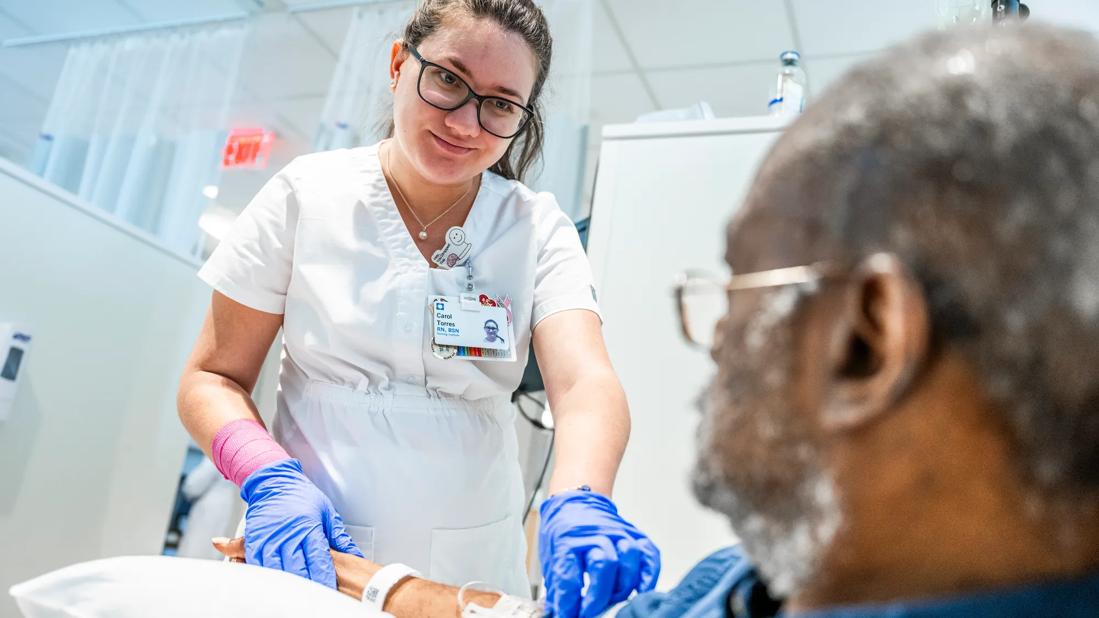Community-based service with big health system resources

By John Baker, DNP, MBA, RN, NEA-BC, Vice President of Nursing and Operations, Cleveland Clinic Akron General Lodi Hospital
Advertisement
Cleveland Clinic is a non-profit academic medical center. Advertising on our site helps support our mission. We do not endorse non-Cleveland Clinic products or services. Policy
Nursing at Cleveland Clinic Akron General Lodi Hospital isn’t like nursing at most hospitals.
With a history that spans 100 years and is rooted in the community, most Lodi nurses have been caring for the people of southwest Medina County for several decades. In fact, you’d be hard-pressed to find many new-graduate nurses among the tenured staff.
Smaller than most community hospitals, Lodi is a Critical Access Hospital. Its 20 beds can be used for varying patient needs, including inpatient, observation and skilled nursing. Approximately 90 percent of Lodi’s patients require skilled nursing. If someone needs inpatient services beyond four days, they are transferred to another Cleveland Clinic location, such as Medina Hospital.
Rounding out Lodi’s services are a fully functioning – and award-winning – emergency department (ED) that has 20 visits per day on average, as well as outpatient surgical and diagnostic services, rehabilitation and physical therapy, radiology services and primary care.
A smaller hospital also means a smaller nursing staff. With roughly 55 registered nurses, including executives, nurse practitioners and licensed practical nurses, and no patient care nursing assistants or hospital unit coordinators, Lodi nurses wear many hats.
Nurse managers help care for patients at the bedside and serve as case managers. Nursing operations managers (NOMs) supervise after hours and on weekends and holidays, as well as offer support to units by picking up other shifts.
The entire nursing team collaborates closely every day. Collaboration is also multi-disciplinary with staff sharing responsibilities as appropriate. During tier 2 daily huddles, managers from all disciplines report on departmental activities. However, managers may support departments outside of their own. For example, medical assistants from primary care might step in to fulfill roles on the inpatient unit, or ED nursing may support respiratory care.
Advertisement
My own role encompasses oversight of nursing and strategy, as well as general hospital operations, including radiology, physical therapy, laboratory services, and hospital ancillary services. Charlene Bunner, BSN, RN, is the nurse manager for surgical services, but also oversees community health, NOMs, the specialty clinic, and fills in for me when I’m not available.
When I came to Lodi Hospital in 2019, I brought 10 years of Cleveland Clinic health system experience, including Cleveland Clinic Children’s and South Pointe. While I enjoyed my previous positions, I immediately found the history and people of Lodi Hospital refreshing. I also recognized opportunities to better integrate Lodi with the rest of the health system and capitalize on the resources available to Lodi nurses.
Within the first weeks of my arrival, our ED nurse manager was telling me about her attempts to follow up with a patient who was dissatisfied with the care they received. I asked myself, “Why aren’t we using the Ombudsman Office?”
After integrating the services of the Ombudsman Office, I introduced other health system resources, including nursing education programs and offerings such as Vascular Access Resource Nurse (VARN) courses. I invited our Associate Chief Nursing Officer for Care Management and Ambulatory Services Kristine Adams, MSN, CNP, and members of her team to assess our case management process. They shared how the enterprise approaches case management and offered suggestions and resources. Today, our case management nurse manager sits on the enterprise-wide Case Management Affinity Group.
Advertisement
Lodi nurses have also benefited from Cleveland Clinic’s Office of Caregiver Experience leadership training. Our management team participated in a two-day training program that made a substantial difference in daily operations. From the experience, we made cross-training nursing staff a priority.
Now, when we interview new hires for inpatient or surgical units, we ask them upfront if they would be willing to cross-train on other units. This has enhanced our resource pool and aided with staffing challenges small hospitals like ours often face.
The need for creative staffing was something we learned all too well during the height of the coronavirus pandemic. At one point, six or seven caregivers were out simultaneously, so we relied on our health system colleagues for support. A nurse from Euclid Hospital remotely assisted with case management updates, and we shared emergency management resources with Medina Hospital.
As Lodi’s nurse leaders look ahead, we see a bright future that continues to include a close-knit culture with familial roots along with Cleveland Clinic’s culture of collaboration and support.
To learn more about nursing at Cleveland Clinic Akron General Lodi Hospital, contact John Baker bakerj10@ccf.org.
Advertisement
Advertisement

Nurses harness cutting-edge technology as a bridge to healing

Project aims to improve patient care by streamlining caregiver transitions

Optimizing care while protecting patients from life-threatening reactions

Palliative nurses improve quality of life

Strong bonds and momentous milestones fuel life-changing work

Experts offer hands-on support and education

Special skills course aims to improve patient safety and comfort while building caregiver confidence

Bariatric nurses deliver sensitivity, compassion and skill